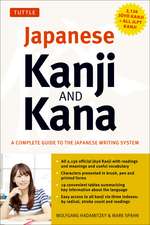What It Takes: Academic Writing in College
Autor Laurence Behrens, Leonard J. Rosenen Limba Engleză Paperback – 30 iun 2012
What It Takes: Academic Writing in College prepares students for the most common college writing assignments: the summary, the critique, the synthesis, and the analysis.
Derived from the top-selling Writing and Reading Across the Curriculum, this very concise, handy guide introduces each of the strategies required for writing successful college papers, and takes students step by step through the process of writing based on source material.
Preț: 433.29 lei
Nou
82.91€ • 86.56$ • 68.62£
Carte disponibilă
Livrare economică 15-29 martie
Specificații
ISBN-10: 0205864848
Pagini: 192
Dimensiuni: 124 x 191 x 10 mm
Greutate: 0.18 kg
Ediția:Revised
Editura: Pearson
Cuprins
Preface
A Note to the Student
CHAPTER 1 Summary
What Is a Summary?
Can a Summary Be Objective?
Using the Summary
Box: Where Do We Find Written Summaries?
The Reading Process
Box: Critical Reading for Summary
How to Write Summaries
Box: Guidelines for Writing Summaries
Demonstration: Summary
"Will Your Job Be Exported?"
Alan S. Blinder
Read, Reread, Highlight
Divide into Stages of Thought
Write a Brief Summary of Each Stage of Thought
Write a Thesis: A Brief Summary of the Entire Passage
Write the First Draft of the Summary
Summary 1: Combine Thesis Sentence with Brief Section Summaries
The Strategy of the Shorter Summary
Summary 2: Combine Thesis Sentence, Section Summaries, and Carefully Chosen Details
The Strategy of the Longer Summary
How Long Should a Summary Be?
Avoiding Plagiarism
Box: Rules for Avoiding Plagiarism
Chapter 2 Critical Reading and Critique
Critical Reading
Question 1: To What Extent Does the Author Succeed in His or Her Purpose?
Box: Where Do We Find Written Critiques?
Writing to Inform
Evaluating Informative Writing
Writing to Persuade
Evaluating Persuasive Writing
"The Moon We Left Behind"
Charles Krauthammer
Persuasive Strategies
Logical Argumentation: Avoiding Logical Fallacies
Box: Tone 49
Writing to Entertain 53
Question 2: To What Extent Do You Agree with the Author?
Identify Points of Agreement and Disagreement
Explore the Reasons for Agreement and Disagreement: Evaluate Assumptions
Inferring and Implying Assumptions
An Example of Hidden Assumptions from the World of Finance
Critique
How to Write Critiques
Box: Guidelines for Writing Critiques
Demonstration: Critique
To What Extent Does the Author Succeed in His or Her Purpose?
To What Extent Do You Agree with the Author? Evaluate Assumptions.
Model Critique: A Critique of Charles Krauthammer's "The Moon We Left Behind"
Box: Critical Reading for Critique
The Strategy of the Critique
Chapter 3 Explanatory Synthesis
What Is a Synthesis?
Summary and Critique as a Basis for Synthesis
Inference: Moving Beyond Summary and Critique
Purpose
Example: Same Sources, Different Uses
Box: Where Do We Find Written Syntheses?
Using Your Sources
Types of Syntheses: Argument
Explanation: News Article from the New York Times
"While Warning About Fat, U.S. Pushes Cheese Sales" - Michael Moss
Argument: Editorial from the Boston Globe
"Got Too Much Cheese?" - Derrick Z. Jackson
What Are Genetically Modified (GM) Foods?
"Genetically Modified Foods and Organisms" - The United States Department of Energy
"Why a GM Freeze?" - The GM Freeze Campaign
How to Write Syntheses
Box: Guidelines for Writing Syntheses
The Argument Synthesis
The Elements of Argument: Claim, Support, and Assumption
Ethos
Pathos
Demonstration: Developing an Argument Synthesis-Balancing Privacy and Safety in the Wake of Virginia Tech
"Mass Shootings at Virginia Tech, April 16, 2007: Report of the Review Panel"
"Virgina Tech Massacre Has Altered Campus Mental Health Systems"
Associated Press
The Family Educational Rights and Privacy Act
Consider Your Purpose
Making a Claim: Formulate a Thesis
Decide How You Will Use Your Source Material
Develop an Organizational Plan
Formulate an Argument Strategy
Draft and Revise Your Synthesis
Model Synthesis: Balancing Privacy and Safety in the Wake of Virginia Tech - David Harrison
The Strategy of the Argument Synthesis
Developing and Organizing the Support for Your Arguments
Summarize, Paraphrase, and Quote Supporting Evidence
Provide Various Types of Evidence and Motivational Appeals
Use Climactic Order
Use Logical or Conventional Order
Present and Respond to Counterarguments
Use Concession
BOX: Developing and Organizing Support for Your Arguments
The Comparison-and-Contrast Synthesis
Organizing Comparison-and-Contrast Syntheses
Organizing by Source or Subject
Organizing by Criteria
A Case for Comparison-and-Contrast: World War I and World War II
Comparison-and-Contrast (Organized by Criteria)
Model Exam Response
The Strategy of the Exam Response
Chapter 4 Analysis
What Is an Analysis?
Box: Where Do We Find Written Analyses?
How to Write Analyses
"The Plug-In Drug"
Marie Winn
Locate and Apply an Analytic Tool
Locate an Analytics Tool
Apply the Analytic Tool
Analysis Across the Curriculum
Box: Guidelines for Writing Analysis
Formulate a Thesis
Develop an Organizational Plan
Turning Key Elements of a Principle or Definition into Questions
Developing the Paragraph-by-Paragraph Logic of Your Paper
Draft and Revise Your Analysis
Write an Analysis, Not a Summary
Make Your Analysis Systematic
Answer the "So What?" Question
Attribute Sources Appropriately
Box: Critical Reading for Analysis
When Your Perspective Guides the Analysis
Demonstration: Analysis
Model Analysis: "The Case of the Missing Kidney: An Analysis of Rumor" - Linda Shanker
The Strategy of the Analysis
Credits
Index
APA Documentation: Basic Formats
MLA Documentation: Basic Formats
Checklist Survey








